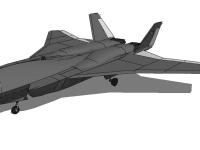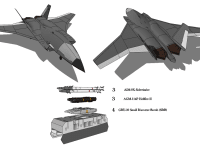The start of widespread use of drones was a significant leap for the world's military & other agencies. Most, if not all designs however, are limited to a particular role.
Current fielded UAV/UCAVS, such as the MQ Predator/Reapers on one hand, primarily employed in surveillance & ground strike roles, lack a real capability of performing air combat & lacking full autonomy, while in the other, drones such as the RQ Global Hawk, whilst having autonomy, lack the capability to attack targets.
How do we address this? The solution is simple: Design/build a UCAV capable of performing not just in ground strike & surveillance roles, but also capable of performing air superiority roles,retaining full autonomy while being stealthly in design considering the advances in technology available to us, & further improve on it, rolled into 1 universal design, not only that, a design that can also be used by multiple branches in a nation's armed forces.
The advantages of having a UCAV with multiple capabilities is significant.
If used by the Air Force, it can perform duties such as:
1. Air Escort
2.Surveillance
3.Ground Strike
4.Combat Air Patrol/Air Superiority
If used by the Navy, notable roles include:
1.Combat Air Patrol/Fleet Defense
2.Air Tanker
These are just a few examples that a single universal UCAV design can perform. Having a universal design also simplifies production while meeting multiple requirements, similar to the F-35 Lightning II, minus the pilot.
As the drone design is fully autonomous,it is less vulnerable to any jamming of command-&-control systems compared to remote-piloted drones such as the Reaper.
Another advantage in having this kind of drone, is that they can be kept aloft for as long as necessary, especially if they are designed with in-flight refueling capabilities. This means that response times are significantly reduced. This can be useful in the event of an enemy attack as the drone is already airborne, unlike manned aircraft that have to be scrambled & directed to the target area which would usually take 10-15 minutes.
Since international law mandates that there be always a "man-in the-loop", a pilot is present only for monitoring flight systems & for authorizing release/use of weapons. Otherwise, full flight is carried out by the drone's own onboard systems.
Drone features:
1. Internal 20mm Gatling (The first of its kind to mount an onboard cannon)
2. Internal weapons bay.
3. Thrust-vectoring nozzles derived from the F-22 Raptor.
4. Twin engines, survivability in event of 1 engine being damaged.
5. Stealthy design based on both the F-22 & F-35
6. Arrestor hook & strengthened landing gear (Navy version only)
The drone can also be equipped with sensors & components used by other aircraft.
The weapons bay can also house various munitions available in the US inventory, wing hardpoints also increase the drones loadout, although with an increased radar signature.
Like this entry?
-
About the Entrant
- Name:Justin Carlo Punay
- Type of entry:individual
- Software used for this entry:Google Sketchup
- Patent status:none








